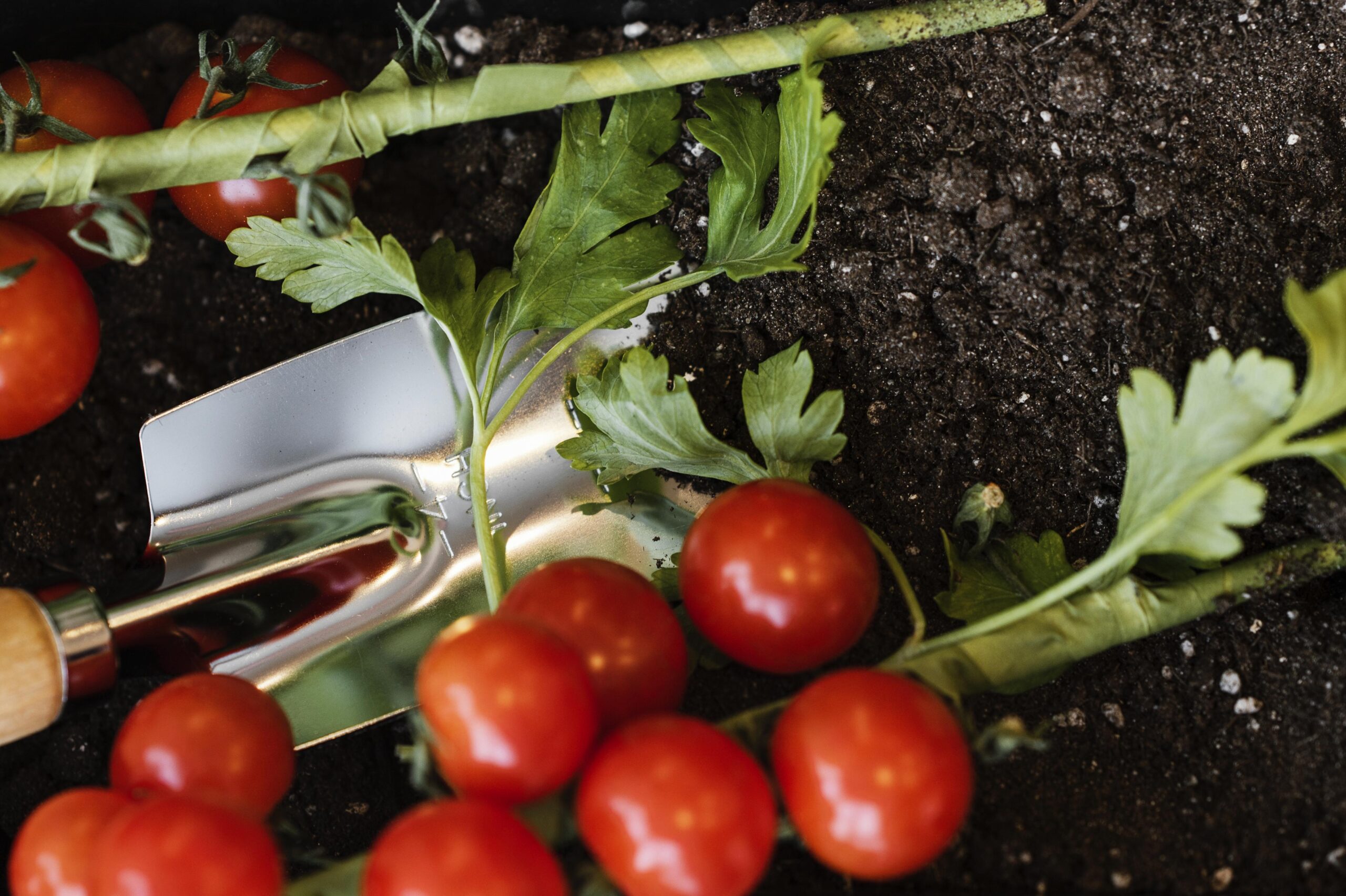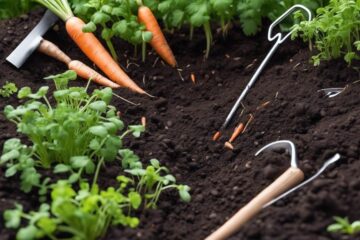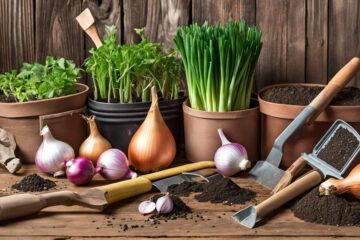When aiming for a fruitful tomato harvest, tackling topsoil prep with precision is paramount. Clearing weeds and tilling diligently sets the stage for success, but the real star of the show? Organic matter.
But what role does this humble addition play in your tomato bounty? Well, let’s just say, it’s the underappreciated secret to unlocking your soil’s full potential.
So, ready to unearth the mysteries behind bountiful harvests?
Importance of Soil Ph for Tomatoes
Maintaining the ideal soil pH level between 6.0 to 6.8 is crucial for ensuring optimal nutrient availability and promoting healthy growth of tomato plants. Tomatoes thrive in slightly acidic soil conditions, which enhance nutrient uptake necessary for their development.
The soil pH directly impacts the availability of essential nutrients like phosphorus, vital for the optimal growth of tomatoes. By monitoring and adjusting soil pH levels, you can prevent nutrient deficiencies and create an environment that supports the flourishing of your tomato plants.
Regularly testing the soil pH is key to understanding and adapting to the specific needs of your plants, ensuring they’ve the best conditions for growth and productivity. Prioritizing the ideal soil pH is fundamental for achieving bountiful tomato harvests.
Organic Matter: The Key to Fertile Soil
Enhancing soil fertility for tomato plants is a multifaceted approach that centers around the incorporation of organic matter, such as compost, manure, and leaf mold. These natural amendments are invaluable for improving soil structure, boosting water retention, and optimizing nutrient availability—key factors for nurturing healthy tomato plants. The introduction of organic matter not only feeds the soil with a rich supply of nutrients but also fosters a thriving community of beneficial microorganisms. These microbes play a pivotal role in enhancing soil health, breaking down organic materials into accessible nutrients for plants, and supporting a balanced ecosystem that promotes plant growth.
Incorporating organic matter regularly into your garden bed cultivates a fertile environment conducive to robust tomato yields. This practice contributes to long-term soil sustainability, enriching the soil with the essential components needed for tomato plants to thrive. Moreover, it bolsters the soil’s resilience against environmental stresses, such as drought and pests, by maintaining an ecosystem that supports beneficial organisms. Together, these strategies form the cornerstone of a productive tomato garden, emphasizing the critical importance of organic matter in achieving fertile, life-sustaining soil for your tomato plants.
Mulching Techniques for Soil Health
Proper Drainage for Tomato Roots
Achieving optimal growth and health for tomato plants necessitates a keen focus on the critical aspect of soil drainage. Proper drainage is paramount in circumventing the perils of waterlogged conditions, which are a primary cause of root rot and a host of fungal diseases. These conditions not only threaten the viability of the plants but can significantly impair their growth and fruit production. When preparing your garden for tomato planting, assessing and ensuring the soil’s ability to effectively drain excess water is essential.
Balancing Nutrients for Robust Growth
A crucial aspect for ensuring robust growth in your tomato plants is balancing the essential nutrients they require. To achieve this, you must consider the following:
- Phosphorus for Root Development: Phosphorus plays a pivotal role in root development, which is foundational for the vitality and stability of tomato plants. A well-established root system enables the plant to absorb water and nutrients more efficiently, supporting its growth and fruit production capabilities. Beyond root development, phosphorus is also instrumental in fruit development, ensuring that tomatoes grow to their full potential and exhibit excellent quality. To cater to the phosphorus needs of your tomatoes, consider using bone meal or phosphate fertilizers, especially during the planting and early growth stages, to encourage a strong start.
- Potassium for Disease Resistance: Potassium is critical for various plant processes, including water uptake, enzyme activation, and photosynthesis. It fortifies the plant against diseases and stresses, such as drought or extreme temperatures, thereby increasing its resilience. Moreover, potassium is known to improve the size, color, and taste of the fruits, directly influencing the quality of your tomato harvest. To ensure your plants receive ample potassium, apply a balanced tomato-specific or vegetable garden fertilizer that prominently features potassium.
- Nitrogen for Leafy Growth: Nitrogen is the driving force behind lush, leafy growth in tomato plants, essential for photosynthesis and overall energy production within the plant. However, it’s crucial to balance nitrogen levels carefully; excessive nitrogen can lead to abundant foliage at the expense of fruit production. Utilize a fertilizer with a balanced N-P-K ratio early in the growing season to encourage healthy vegetative growth. As the plants begin to flower and set fruit, consider switching to a lower-nitrogen formula to focus the plant’s energy on fruit production.
- Soil pH and Nutrient Availability: The soil pH plays a critical role in nutrient availability to tomato plants. Most tomatoes prefer slightly acidic to neutral pH levels (around 6.0 to 7.0), within which nutrients are most readily available for absorption. Test your soil’s pH regularly and amend it as necessary to maintain these optimal conditions. Adjustments can be made using lime to raise pH or sulfur to lower it, depending on your specific soil conditions.
- Customized Fertilizer Applications for Targeted Nutrition: Monitoring and adjusting fertilizer applications according to the growth stage and observable needs of your tomato plants are paramount for their success. Tailor your fertilization strategy to provide the right nutrients at the right times, ensuring that your plants have all they require for vigorous growth, disease resistance, and prolific fruiting.
By meticulously managing the balance of phosphorus, potassium, and nitrogen, along with maintaining an optimal soil pH, gardeners can create an ideal nutritional environment for tomato plants. This strategic approach to nutrient management underpins not only the health and vigor of the plants but also the quality and abundance of the harvest, culminating in a rewarding gardening experience.
Frequently Asked Questions
What Should I Add to My Soil Before Planting Tomatoes?
Before planting tomatoes, add organic matter like compost or aged manure to enrich the soil. Incorporate crushed eggshells for calcium and vermicompost for improved structure. Also, consider bone meal for root development. Test soil for deficiencies and adjust amendments accordingly.
What Is the Best Soil Mixture for Tomatoes?
For your tomatoes, the best soil mix blends topsoil, compost, and organic matter. Ensure good drainage to prevent root rot. Aim for a pH of 6.0-6.8. Add perlite or vermiculite for aeration. Use balanced fertilizers to boost nutrients and support healthy growth.
How Do You Get the Highest Yield on Tomatoes?
To get the highest yield on tomatoes, you must plant disease-resistant varieties, space them adequately, use balanced fertilizers, prune effectively, and water consistently. Yes, it takes effort, but the juicy, plentiful harvest is worth it.
How Can I Improve My Tomato Harvest?
To improve your tomato harvest, amend soil with compost for nutrients, test pH levels, add organic matter for water retention, rotate planting spots yearly, and consider raised beds for optimal growth conditions. Maximize yield with these steps.
Conclusion
Now that you’ve prepared your topsoil for a bountiful tomato harvest, remember that your soil is like a nourishing blanket, cradling your plants with all the nutrients they need to thrive.
By maintaining the right pH level, adding organic matter, mulching, ensuring proper drainage, and balancing nutrients, you’re setting the stage for a fruitful tomato season.
Keep nurturing your soil like a loving gardener tends to their garden, and watch your tomatoes flourish! Check our other tips for growing vegetables!





